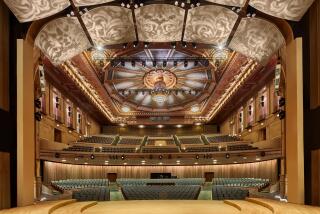Lerman’s Ambitious ‘Hallelujah’ Lost in L.A.
- Share via
Using a rented platform stage and uncomfortable temporary seating, the Skirball Cultural Center launched its Ahmanson Hall as a new performing space Saturday with Liz Lerman’s multi-generational, multicultural, multidisciplinary dance-based epic “Hallelujah.”
Lerman had incorporated many different Skirball spaces into an imaginative site-specific dance event two years ago and, unfortunately, Ahmanson Hall proved less atmospheric than any of them. (Where’s Liberty’s torch when you really need it?)
Except for its tent-like canopy overhead, the hall vaguely resembled the cold, gray lobby of the L.A. Theatre Center downtown: stone pillars and doors on the stage level with a gallery above that allowed additional seating as well as extra playing areas.
Reportedly holding 375 spectators in its Saturday configuration (with the audience on three sides of the stage), the hall seemed somehow adapted rather than designed for performances: a multipurpose room with problematic access and sight lines. But its potential as a center for educational and experimental dance should not be underestimated.
Lerman explored its possibilities resourcefully, but the long-awaited Los Angeles chapter of her four-year, ever-changing “Hallelujah” project looked unfinished, hyperactive and uninvolving at its premiere. For starters, its treatment of local diversity ignored present-day realities for a nostalgic peek backward to a time when the most prominent minorities here were African Americans, Japanese Americans and Jews.
So no Latino presence enriched “Hallelujah,” no Hinduism amplified its tribute to Christian, Buddhist and Jewish faiths. And no Islam. In other words, no L.A.
The evening began with five short pieces--all choreographed by Lerman in a restless, extroverted modern dance style except for the excerpts from Bebe Miller’s “Blessed” in which the eight dancers of Lerman’s Washington, D.C.-based Liz Lerman Dance Exchange momentarily found opportunities to define genuine feeling, intimacy, weight of character and the quality of being quietly centered in the space.
Lerman’s “Hallelujah: Gates of Praise” set them busily manipulating three triangular sculpture units designed by Lewis Folden. The excepts from her “In Praise of Fertile Fields” began with the acting out of vintage texts about modern dance, expanding to forceful group choreography.
“Hard Work” propelled 10 dancers from the local community through brief, sometimes violent connections and patterns of support. “Let’s Get Started” used Kenny Endo’s explosive drumming as a kind of force-field for hard-driving gymnastic interactions, with occasional, fleeting movement games helping to humanize the effect.
After intermission came the main event: “Hallelujah: Stones Will Float, Leaves Will Sink, Paths Will Cross.” Punctuated with pithy statements by six local spiritual leaders and by swirling dance sequences merging Lerman’s troupe with members of the L.A. community, this collaborative extravaganza depended heavily on the charismatic Nobuko Miyamoto as singer, writer, co-choreographer and family historian.
Celeste Miller and Kazu Nakamura effectively played Miyamoto’s grandmothers, and their stories became the nominal structure for the piece. Lerman added her own witty remarks, and the Gwen Wyatt Chorale provided gospel fervor aplenty. Platoons of musicians and technicians labored mightily with faultless skill.
But the result never held together, not nearly. Sprawling, half-baked, too obsessed with high-minded homilies and a generalized performance vitality, “Hallelujah” never managed to touch a spiritual or emotional core--not even in its death scenes, though Nakamura’s came close. Think of it as a cultural disaster epic with lots of talented artists running around desperately looking for artistic direction instead of lifeboats.
More to Read
The biggest entertainment stories
Get our big stories about Hollywood, film, television, music, arts, culture and more right in your inbox as soon as they publish.
You may occasionally receive promotional content from the Los Angeles Times.










